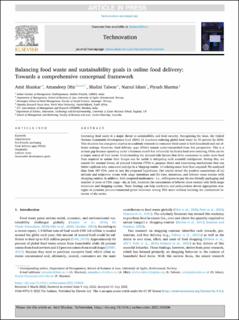| dc.contributor.author | Shankar, Amit | |
| dc.contributor.author | Dhir, Amandeep | |
| dc.contributor.author | Talwar, Shalini | |
| dc.contributor.author | Islam, Nazrul | |
| dc.contributor.author | Sharma, Piyush | |
| dc.date.accessioned | 2022-09-07T13:35:06Z | |
| dc.date.available | 2022-09-07T13:35:06Z | |
| dc.date.created | 2022-08-11T17:13:10Z | |
| dc.date.issued | 2022-07-30 | |
| dc.identifier.citation | Shankar, A., Dhir, A., Talwar, S., Islam, N., & Sharma, P. (2022). Balancing food waste and sustainability goals in online food delivery: Towards a comprehensive conceptual framework. Technovation, 102606. | en_US |
| dc.identifier.issn | 0166-4972 | |
| dc.identifier.uri | https://hdl.handle.net/11250/3016364 | |
| dc.description.abstract | Increasing food waste is a major threat to sustainability and food security. Recognizing the issue, the United Nations Sustainable Development Goal (SDG) 12 mandates reducing global food waste by 50 percent by 2030. This situation has also given impetus to academic research on consumer food waste in both household and out-of-home settings. However, food delivery apps (FDAs) remain under-researched from this perspective. This is a serious gap because operating under a business model that inherently facilitates food over-ordering, FDAs can be a major source of food waste. Understanding the demand-side factors that drive consumers to order more food than required to satiate their hunger can be useful in mitigating such wasteful indulgences. Noting this, we extend the seminal theory of planned behavior (TPB) to propose direct and intervening mechanisms that can better explicate why consumers indulge in a ‘shopping routine’ of ordering more food than required. We analyzed data from 487 FDA users to test the proposed hypotheses. Our results reveal the positive associations of (a) attitude and subjective norms with usage intentions and (b) trust, intentions, and leftover reuse routine with shopping routine. In addition, both proposed moderators—i.e., willingness to pay for eco-friendly packaging and number of years of FDA usage—do, in fact, moderate the associations of leftover reuse routine with both usage intentions and shopping routine. These findings can help marketers and policymakers devise appropriate strategies to promote pro-environmental green behaviors among FDA users without harming the commercial interests of the sector. | en_US |
| dc.language.iso | eng | en_US |
| dc.publisher | Elsevier | en_US |
| dc.rights | Navngivelse 4.0 Internasjonal | * |
| dc.rights.uri | http://creativecommons.org/licenses/by/4.0/deed.no | * |
| dc.subject | digitalization | en_US |
| dc.subject | eco-friendly packaging | en_US |
| dc.subject | food delivery apps (FDAs) | en_US |
| dc.subject | hospitality | en_US |
| dc.subject | leftover reuse | en_US |
| dc.subject | sustainable development goals | en_US |
| dc.title | Balancing food waste and sustainability goals in online food delivery: Towards a comprehensive conceptual framework | en_US |
| dc.type | Journal article | en_US |
| dc.type | Peer reviewed | en_US |
| dc.description.version | publishedVersion | en_US |
| dc.rights.holder | The authors | en_US |
| dc.subject.nsi | VDP::Social science: 200 | en_US |
| dc.source.pagenumber | 1-12 | en_US |
| dc.source.journal | Technovation | en_US |
| dc.identifier.doi | 10.1016/j.technovation.2022.102606 | |
| dc.identifier.cristin | 2042538 | |
| cristin.ispublished | true | |
| cristin.fulltext | original | |
| cristin.qualitycode | 2 | |

